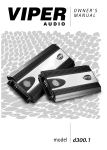Download Polk Audio PA D1000.1 Owner`s manual
Transcript
P A D1000.1 MONOBLOCK AM P L I F I E R 2 English Introduction 3a 3b 4a 4b 5 6 7 TOOLS OF THE TRADE Thank you for your purchase of a Polk Audio PA D Series amplifier. Each PA D Series amplifier is designed to be the leader in its class offering the most power, advanced features, and extreme ease of use. In high-end sound systems or high SPL systems, PA D Series amplifiers will give you years of trouble-free performance. • PA D1000.1—1200W x 1 RMS @ 1 Ohm; 800W x 1 RMS @ 2 Ohms; 500W x 1 RMS @ 4 Ohms. Note: Improper installation will not only limit the performance of your Polk Audio PA D Series amplifier but also potentially compromise the reliability of this amplifier. To ensure proper sonic results and component reliability, please refer to your authorized dealer for installation assistance or advice. If you decide to perform the installation yourself, be sure to read the entire manual before beginning the installation (see Installation Guidelines on page 8). Listed next are the majority of the tools required to perform an installation. INPUT OUTPUT Having the proper tools will make the installation that much easier. LPF HPF L X-OVER X-OVER • Solderless, crimp-on connectors Land a crimping tool • Phillips head screwdriver 1 FREQ x 1 FREQ x 1 HPF LPF HPF LEVEL • Electric drill and 3/16" and FULL 1/8" drill bits • Safety glasses BPF R R • DMM or VOM • Permanent ink marker or pencil 50Hz 500Hz 20Hz 400Hz 6V 200mV FREQ x 10 FREQ x 10 • Safety glasses • Nylon tie straps • Wire crimper • Wire strippers and cutters • Electrical tape • Grommets for passing wires through metal car walls • Amplifier Power Wire RECORD THIS INFORMATION FOR YOUR RECORDS End Panel Layouts Model:__________________________________________________ PA D1000.1 Line Level Inputs/Outputs/Controls 2 Serial Number:____________________________________________ 3 4 5 6 7 8 Date of Purchase:__________________________________________ WHAT’S IN THE BOX • Polk Audio Amplifier • Remote Level Control • Remote Level Control Wire • Phillips Screws (8) • Owner’s Manual • Terminal Block Adaptor • Online Registration Card Important Note: If anything is missing or damaged, or if your Polk Audio amplifier fails to operate, notify your dealer immediately. We recommend keeping your original carton and packing materials in case you need to ship the unit in the future. 1 1. Status LEDs (on top of amplifier): Power and Protection—Power will illuminate to indicate the amplifier is on and operating normally; protection will illuminate if the amplifier shuts down due to short circuit, DC offset, or overheating detected by onboard protection circuitry. 2.Remote Level Control—Connects remote bass control module. 3. LPF Variable Control—Adjusts the low pass filter frequency to attenuate frequencies above the setting on the control. 4. Sub Sonic Filter—Variable from 20Hz - 38Hz. 5. Bass Boost Control—Variable bass gain from 0dB - 12dB. 6. Level Control—Adjusts the gain of the channel to match the output voltage from your head unit. 7. Line Level Inputs—Accepts Line level input from a source unit, preamplifier, or equalizer. 8. Line Level Outputs—Provides a full range signal for easy connection to additional amplifiers. PA D1000.1 Power Inputs/Speaker Outputs 1 2 3 4 5 1.GND (Ground)—Connect this terminal directly to the metal chassis of the vehicle, using the shortest wire necessary to make this connection. Always use wire of the same gauge or larger than the +12V power wire. The chassis connection point should be scraped free of paint and dirt. Use only quality crimped and/or soldered connectors at both ends of this wire. DO NOT connect this terminal directly to the vehicle battery ground terminal or any other factory ground points. 2.REM (Remote Turn On)—This terminal turns on the amplifier when +12V is applied to it. Connect it to the remote turn on lead of the head unit. 3. +12V Power—Connect this terminal through a FUSE or CIRCUIT BREAKER to the positive terminal of the vehicle battery or the positive terminal of an isolated audio system battery. WARNING: Always protect this power wire by installing a fuse or circuit breaker of the appropriate size within 12" of the battery terminal connection. 4.Fuse—These fuses (40A x 3) protect the amplifier against internal electrical damage and are meant to protect only the amplifier. All other power connections should be fused at the power source. 5. Speaker Output—Connect your subwoofers here. 6. Terminal Adaptor—The adaptor enables the use of cable up to 0000AWG for the ground and +12V connections (see illustration below). 1000.1 Speaker Wiring Diagram PA D1000.1 The Polk Audio PA D1000.1 amplifier offers two positive and two negative output terminals for ease of connecting the speakers to the amplifier. Since this is a mono amplifier, connections are wired in paralleled internally. The amplifier is stable to 1 Ohm. 1Ω min 2Ω min 2Ω min Amplifier Installation 2000.2 Mounting Locations The location of your amplifier will depend on several important issues. Due to the low profile and compact size of the Polk Audio PA D Series amplifier, there are many possible installation locations that will yield satisfactory amplifier performance. Always mount the amplifier in a place that protects the amplifier from the elements. In addition, mount the amplifier on a stable, flat surface. NOTE: MountingBRIDGED amplifiers upside down is not recommendedBRIDGED and may cause premature thermal shutdown. WARNING! Do not mount any amplifier in the engine compartment. Amplifiers are not designed GND REM 12V to endure the harsh environment of an engine compartment. L 6.Terminal Adaptor Amplifier Wiring R R 25A 25A L L R R Trunk Compartment 4Ω min 2Ω min Mounting your amplifier in the trunk provides excellent performance as long as you do not restrict the airflow around the heatsink of the amplifier. For optimal results, mount the amplifier with as much clearance as possible. 2Ω min This type of mounting will yield the best cooling due to the convection effect of the amplifier chassis. 4000.4 RR FL RL FR RR FL FR FRONT FRONT REAR RL REAR Power Connections • PA D1000.1 Fuse Size: 3 x 40 AMP ATC. • Power connections accept up to 4 AWG wire. • 4 AWG power and ground wire recommended for optimal performance. • Connect +12V to the battery through fuse holder. This connection provides +12V main power to the amplifier. • Power wire must be fused within 12" of the battery. • Ground the amplifier using a good chassis ground as close as possible to the amplifier. • Connect REM terminal to remote turn-on lead from the head unit. This connection provides +12V power to turn-on the amplifier. • Add extra ground wire between the negative terminal of the battery and the chassis. L Passenger Compartment If you are going to mount the amplifier in the passenger compartment, make sure you have adequate room for ventilation. When mounting your amplifier under a seat or similar area, keep a minimum of 1" of clearance around the amplifier for adequate cooling. INSTALLATION GUIDELINES Power for systems with a single amplifier can be supplied by most automotive electrical systems. Systems with multiple amplifiers may require a higher capacity battery, alternator or the use of a storage capacitor. Polk Audio PA D Series amplifiers do generate a certain amount of heat as part of normal operation. Be sure the area around the amplifier is unobstructed to allow adequate air circulation. Remember, beach blankets, last week’s laundry, school books and homework papers placed on top of the amplifier impede air flow and may cause damage. Please read this owner’s manual carefully before installing your amplifier. 1. 2. Disconnect the battery ground terminal prior to making any electrical connections. Check for any hazards or obstructions such as gas tanks, fuel or brake lines, and wiring harnesses 3. before mounting the amplifier. 4. Pick a mounting location that will provide adequate access and ventilation and protect the amplifier from heat, moisture, and dirt. 5. Avoid sharp metal areas when routing cables to the amplifier, and run RCA cables away from the power cables and other potentially noisy car harnesses. 6. The amplifier should be grounded with a short, heavy gauge wire connected directly to the car at a bare metal surface, preferably scraped body metal. Do not use factory ground locations, seat bolts, or brackets that are spot welded. 7. Always fuse your power connection within 12 inches of the battery terminal. Use a fuse or circuit breaker rated slightly more than the on-board fuse(s) of the amplifier(s). The gauge of power wire used should take into account the total current draw of the system, and the length of wire used. IASCA and other auto sound competition organizations have charts available for this; you can also find a chart in the MECP study guide. Minimum wire gauge recommendations for the individual amplifiers are listed on the specification page. Always use the same gauge wire for the amplifier ground that you use for the power wire. Be sure to examine the battery ground cable of the vehicle, and if necessary, upgrade it by adding an additional ground wire that is the same gauge as the amplifier’s power wire. Remember, the amplifier can only deliver its rated output when it is not current limited by the power and ground supply wires. This amplifier is designed to drive a speaker load that measures from 1 to 8 Ohms. Keep in mind 8. that heat is the long-term enemy of automotive electronics and the lower your speaker load, the more heat is generated. For low-impedance speaker applications or restricted ventilation installations, an external cooling fan may be advisable. 9. Battery and ground connections to the vehicle should be made with crimped ring terminals of the appropriate size (surface area is what counts;) soldering the terminals after crimping is also recommended. 10. Due to the high-frequency MOSFET switching power supply, filtering the power cable is not generally required (remember that the amp can’t deliver full output if the power supply is restricted.) Proper grounding of the signal source is mandatory for the amplifier to reach its performance peak. If the RCA inputs are not grounded adequately via the signal source, electrical noise from the vehicle may be picked up in the system. Step By Step Installation 1. Determine the location for the amplifier. Refer to the Mounting Locations section of this guide for detailed information. 2. Decide on the system configuration for your amplifier. For system suggestions, refer to the Speaker Wiring Diagrams section of this guide. 3. Run all the wires from the amplifier location to the speakers, source unit, and battery. Do not connect the battery at this time. Be sure to run Line levels and power and speaker wires away from factory electrical wires and system as they pose a great potential for induced system noise. 4. Pre-drill amplifier mounting holes. Be sure to “think before you drill.“ Gas tanks, fuel lines, and other obstructions have a nasty way of hiding themselves. For best results use a marking pen to mark the mounting holes and pre-drill these holes with a standard 1/8" drill bit. 5. Mount the amplifier. Make sure the amplifier is mounted on a flat surface. If this is not possible, do not over tighten the screws so that the chassis of the amplifier is twisted or bent. 6. Turn the vehicle’s key switch to the off position. 7. Disconnect the vehicle’s battery ground terminal. 8. Connect power wires to the amplifier (ground first, then +12V and REM). 9. Connect the line level and speaker wires to the amplifier. Check the quality of your speakers and signal connections. This will determine the ultimate performance of your Polk Audio PA D Series amplifier. Refer to the Line Level Inputs/Outputs/Controls and Speaker Wiring Diagrams sections of this guide for correct wiring instructions. 10.Reconnect the ground terminal to the battery after power, speaker, and line level connections are completed. 11. Set crossovers. Refer to the Line Level Inputs/Outputs/Controls section of this manual for detailed instructions. 12. Once satisfied that all connections and settings are correct, install the fuse located near the vehicle’s battery and proceed to the Testing the System section of this manual. WARNING! Never exceed the recommended fuse size of this amplifier. Failure to do so will result in the voiding of your warranty and possible damage to the amplifier. SET UP AND TROUBLESHOOTING Testing the System After you have completed the installation, you need to test the system. This will help ensure years of trouble-free operation. Please refer to the listed steps below when testing the sound of your Polk Audio PA D Series amplifier. 1. Check all the wiring connections to be sure they are correct and secure. 2. Turn the signal source volume control all the way down. Set any tone controls to their flat or defeated positions. This includes the loudness control. 3. Turn the level controls of the amplifier to their minimum positions. 4. Turn the head unit on. Check to see if the power LED located on the connection side of the amplifier is on. If not, please refer to the Power Inputs/Speaker Outputs and the Troubleshooting Tips sections of this manual for instructions. 5. If using an aftermarket head unit, turn the level controls of the amplifier about one quarter of a turn counterclockwise. Slowly increase the volume level of the head unit so that you can hear the output of the system. If no sound is heard or if the output is distorted, turn the system off immediately. Refer to the Power Inputs/Speaker Outputs and the Troubleshooting Tips sections of this manual to solve your installation problems. 6. Check to make sure the output for each channel is correct. If the active crossovers are used, check to make sure that each output is correct from the amplifier. When using active crossovers on midrange and tweeters, do not use crossover frequencies lower than recommended. If the system is not configured properly, refer to the Line Level Inputs/Outputs/Controls section of this manual and take corrective action. 7. If the output is clear and undistorted, continue to the Adjusting the Sound of the System section of this manual. Adjusting the Sound of the System Once you have checked the system’s operation, adjust the sound of the system. Adjusting the sound of the system is accomplished by setting the level controls and adjusting the internal crossovers (see Line Level Inputs/Outputs/Controls on page 5). 1. Turn the signal source volume control all the way down. Set any tone controls to their flat or defeated positions. This includes the loudness control. 2. Turn the level controls of the amplifier to their minimum positions. 3. Choose music with high dynamic content that you like, with which you are familiar, and will be used most often in the system. 4. Turn the head unit’s volume control up to its highest undistorted output level. If you lack test equipment, this point occurs between 3/4 to full volume depending on the quality of your head unit. Listen for any audible distortion. If any distortion is audible, reduce the volume of the head unit until you have an undistorted output. Leave the volume control at this position during your system tuning. 5. While listening to your chosen dynamic music, turn up the level control corresponding to the midrange output until you hear slight distortion and turn the level control back slightly for an undistorted output. Depending on your system, the midrange and tweeter output may be on the same output channels. 6. Turn up the level control corresponding to the tweeter output until you hear slight distortion and turn back the level control slightly for an undistorted output. Depending on your system the midrange and tweeter output may be on the same output channels. 7. Fine-tune the output level between midrange and tweeters. Refer to the Line Level Inputs/Outputs/Controls section of this manual for detailed instructions. 8. Repeat Steps 5-7 for the rear speakers. If you do not have rear speakers continue to Step 10. 9. Set levels between the front and rear midrange and tweeters for optimum front/rear balance. 10.Turn up the level control corresponding to the woofer output until you hear slight distortion and turn back the level control slightly for an undistorted output. 11.Fine-tune the output level between satellite speakers and the woofers. Refer to the Line Level Inputs/Outputs/Controls section of this manual for controls. Adjust the level to the bass output of the woofer to match the sonic requirements of the system. 12.Enjoy your awesome Polk Audio PA D Series amplifier. Troubleshooting Tips Symptom Probable Cause Troubleshooting Tips Symptom Action To Take Probable Cause Distorted output Internal crossover not set properly for speakers Readjust crossovers. Refer to the Amplifier Settings section of this manual for detailed instructions. Speakers are blown Check system with known working speakers and fix or replace as needed. Poor bass response Speakers wired with wrong polarity causing cancellation at low frequencies. Check speaker polarity and fix as needed. Crossover set incorrectly. Reset crossovers. Refer to the Line Level Input/Output/Control section of this manual. Impedance load at amplifier is too low. Check speaker impedance load if below 1 Ohm, rewire speakers to achieve higher impedance. Action To Take Battery fuse blowing No output Low or no remote turn-on. Check remote turn-on at amplifier and repair as needed. Short in power wire or incorrect wiring. Fuse blown. Check power wire’s integrity and check for speaker shorts. Fix as needed and replace fuse. Check power wires and ground connections and repair or replace as needed. Fuse used is smaller than recommended. Replace with proper fuse size. Actual current exceeds fuse rating. Check speaker impedance load if below 1 Ohm, rewire speakers to achieve higher impedance. Power wires not connected. Check power wire and ground connections and repair or replace as needed. Audio input not connected. Check line level connections and repair or replace as needed. Fuse used is smaller than recommended. Replace with proper fuse size. Speaker wires not connected. Check speaker wires and repair or replace as needed. Impedance load at amplifier is too low. Speakers are blown. Check system with known working speaker and repair or replace speakers as needed. Check speaker impedance load if below 1 Ohm, rewire speakers to achieve higher impedance. Speaker is blown with shorted outputs. Check system with known working speakers and fix or replace as needed. Actual current exceeds fuse rating. Check speaker impedance load if below 1 Ohm, rewire speakers to achieve higher impedance. Amplifier fuse blowing Audio cycles on and off Thermal protection engages when amplifier heat sink temperature exceeds 85° C (185° F). Make sure there is proper ventilation for amplifier and improve ventilation as needed. Loose or poor audio input. Check line level connections and repair or replace as needed. Loose power connections. Check power wires and ground connections and repair or replace as needed. Distorted output Amplifier level sensitivity set too high exceeding maximum capability of amplifier. Readjust gain. Refer to the Adjusting the Sound of the System section of this manual. Impedance load to amplifier too low. Check speaker impedance load if below 1 Ohm, rewire speakers to achieve higher impedance. Shorted speaker wires. Check speaker wires and repair or replace as needed. Speaker not connected to amplifier properly. Check speaker wires and repair or replace as needed. POLK AUDIO CAR AMPLIFIERS















